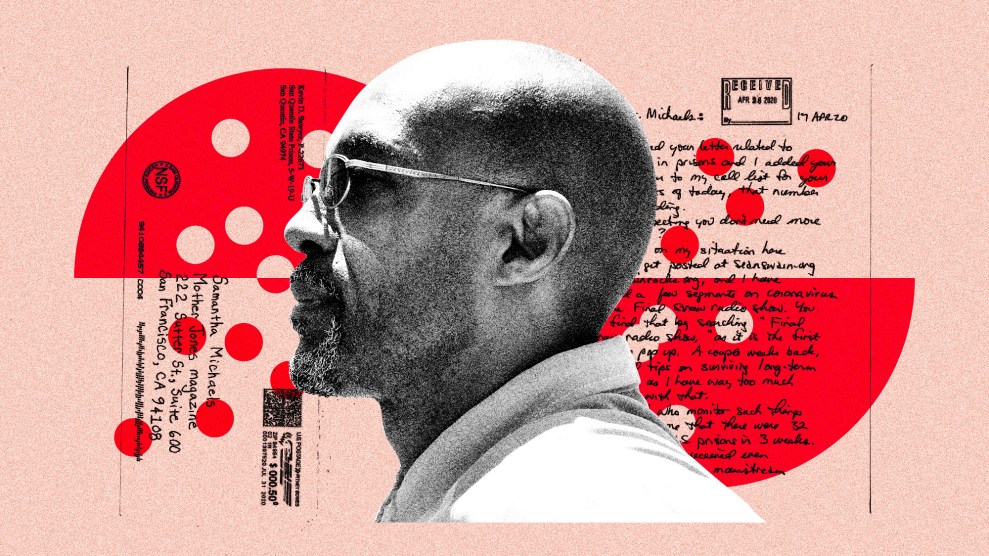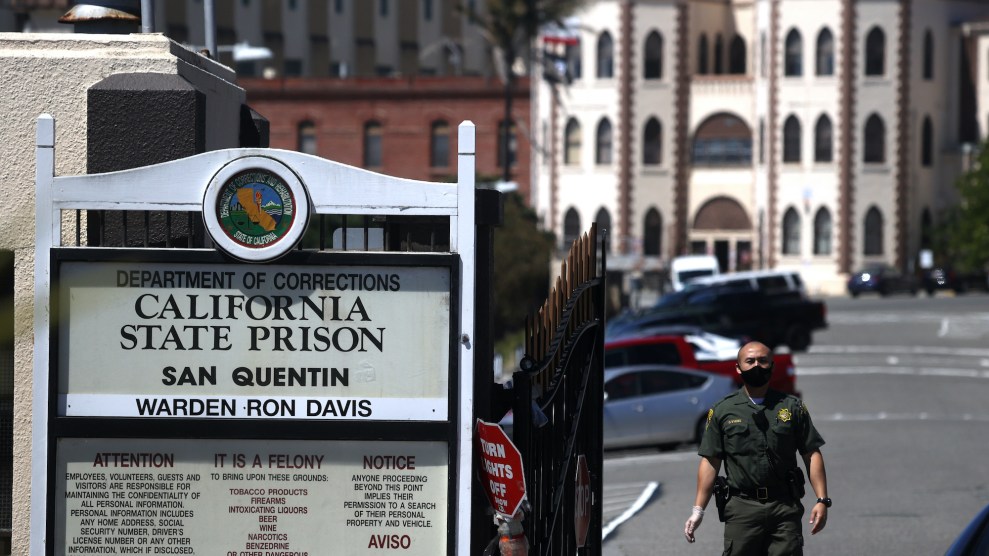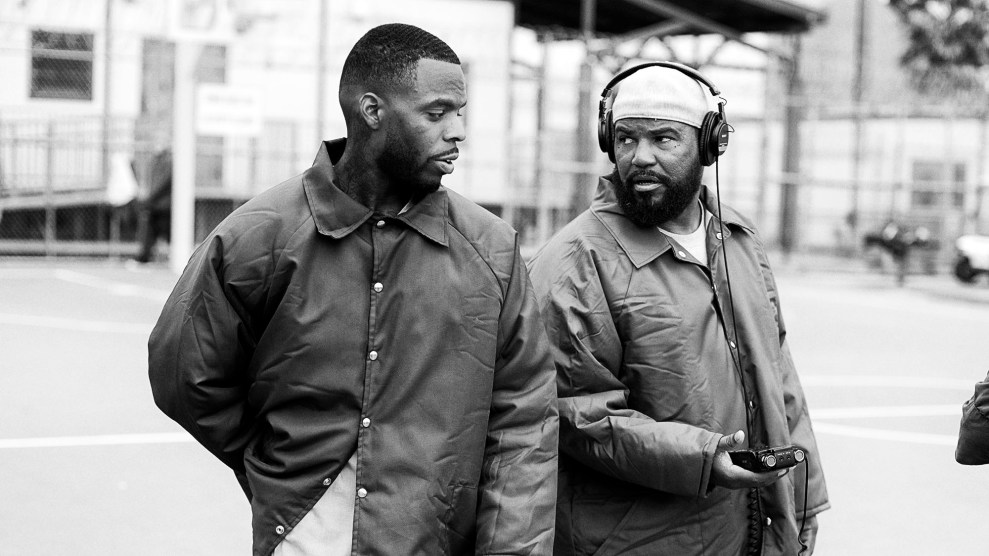
Mother Jones illustration; Eddie Herena
On the top bunk of his cell in San Quentin State Prison, Kevin Sawyer has been chronicling one of the country’s fastest-spreading coronavirus outbreaks on a Brother ML-300 typewriter.
Sawyer, 56, is serving a 48-year-to-life sentence. He’s also associate editor of the San Quentin News, one of a small number of newspapers in the country produced entirely by incarcerated people. When California prisons went on lockdown in March, San Quentin prison officials suspended the newspaper’s operations. “Luckily,” he wrote on his typewriter soon after, “San Quentin State Prison hasn’t been faced with the challenge to maneuver through the crisis on the same scale that has overwhelmed the nation, at least not yet. But if COVID-19 does strike California’s oldest prison, the inmates there are doomed, because the state, like the rest of America, does not appear to have a viable plan to handle this kind of emergency.”
Even though San Quentin had no cases of COVID-19 at that time, inmates had to spend almost all day in their housing units out of precaution. Sawyer was determined to keep reporting, even if he would have to conduct his interviews by passing notes between cells.
In April, after we’d been writing letters to each other for a few weeks, he wrote to me to explain the creative ways he produces journalism behind bars:
I collect memos and fliers that are posted around the prison or passed out to each cell. Sometimes I document what’s posted on the bulletin boards located in the West Block housing unit. I interview inmates when we are released to go to the recreation yard every few days. I record what my five senses reveal to me. I take all of the lose papers and organize them in chronological order. (Oops! I’m not on a word processor so I spelled loose incorrectly.) Then I string a storyline together, handwritten. Because I have a portable word processor (NEO, made by Alphasmart), I’m able to organize this information into what I hope is a cogent and interesting story for readers. The NEO can output information to a PC via a USB cable, but because that’s not an option inside a prison cell, I scroll through the 5” x 2” LCD screen and retype the text on my Brother ML-300 electric typewriter.
In my cell, I keep names and addresses of outside media (including yours, obviously) that I acquired over the years. In a single word, prepared is what I am. I was that way before prison so it wasn’t a major shift in consciousness for me.
In anticipation of a lockdown or some other untimely event, I keep extra typewriter ribbons in my cell, typing paper, stationary, pens, Post-It note pads, carbon paper (to maintain a record or backup copy), Penal Code, two legal dictionaries, a regular dictionary and thesaurus, California Code of Regulations, Title 15, Prisoners Self-Help Litigation Handbook, California State Prisoners Handbook (published by the Prison Law Office), California Rules of Court, a Spanish-English dictionary, a French-English dictionary, regular lined paper, 28-line legal paper, felt pens that highlight, notes from the 400-plus books that I’ve read in the last 23 years, envelopes, postage stamps, The Bedford Handbook for Writers, The Blue Book (A system of uniform legal citation—think AP style guide), and probably a few things I’ve overlooked like paper clips.
One way I do interviews on lockdown is to write notes with questions. Inmates are sometimes more willing to write about what’s happening to them instead of filing a grievance. Because of my tenure and reputation with San Quentin News, they know me and trust that I will not exploit them or place them in a negative light. Sometimes I interview using the NEO or I’ll simply use pen and paper to do a one-on-one. If I have to send a note to an inmate while I’m in my cell, I’ll ask a porter or someone who’s out on the tier to take the note to the person. If it’s in a sealed envelope I have to inform the “runner” of the “kite” (prison slang for a letter or note) that it’s not “hot.” That means there is no incriminating or illegal information in the note, that if intercepted by a correctional officer during a random search it will not subject the runner to disciplinary treatment. Believe me, it happens. Not with me, but I still follow prison etiquette and protocol when asking for a favor. It’s all about trust and one’s reputation, so it’s never cool to put someone in a situation that they are not aware of or willing to accept the consequences.
Because there are so many prisoners in one building, I have unfettered access to them. The interviewing is easy, but I like to add “different facts and data to stories. Sometimes I’m able to overcome that obstacle by watching television news or referring to information in newspapers, magazines, books, and other material I may have in my cell, such as law books.
You asked, “What’s it like to write on a typewriter, and where did (I) get it?” If you weren’t a reporter, I’d say you’re nosey (smile). Have you ever typed on a typewriter? It’s actually really easy, even fun. Once my work is organized and edited on paper, the typewriter serves as another means of outputting the information. I’m 56 years old, so I grew up using typewriters. In junior high school I learned to type on a manual typewriter. Other than correcting mistakes (like “lose” versus “loose”) with correction tape instead of a software insert, it’s no big deal. And I type from the home key position, without looking. Mr. Talerico (Hillview Jr. High) would be proud of me. My late mother purchased the typewriter for me in 2003 from the vendor Walkenhorst’s, mainly to do legal work, but it has served many other purposes. I think it cost about $150.
Sawyer was born in San Francisco. He dreamed of majoring in business in college, but he dropped out after his son was born, and started working at a telecommunications company. This, in some ways, started him down the road toward journalism. “When I went back to school in 1990, I wanted to major in telecommunication, but California State University Hayward (now East Bay) had no such major,” he wrote to me. “The closest thing to telecom was mass communication, which focused on public relations, advertising, broadcasting and print journalism.” After graduating, he landed in prison in 1998. He soon felt the urge to write:
The two years I spent in county jail fighting the numerous charges against me (Trina Thompson, the Ghost Ship trial judge, was my first private attorney), I wrote about the experience in 23 different journals on the same sized paper that you used to handwrite your last letter to me. One of those journals (#9) got me a trip to the hole for 90 days. When I arrived in state prison, I started writing personal political essays and memoirs. I had my college AP book sent to me but never found a use for it because there wasn’t a newspaper to write for and I was an unknown in the journalism world. I kept writing and reading, though.
By the time I arrived at San Quentin, I’d been incarcerated 15 years, and I’d read 296 books that I’d extracted many notes from. By then I’d also written quite a bit. Then I discovered a little prison publication called San Quentin News. I joined its journalism guild immediately, but I didn’t want to be a staff writer. A job assignment washing dirty food trays at 3:00 a.m. changed my mind. A few months after being hired I was asked to run the guild. Reluctantly, I accepted and did the job for three years. Many of the operating procedures that are in place today, I established. I moved to the associate editor position about four years ago. Technically, I am the paper’s number two man who runs the business side of the operation. That involves me overseeing that the five of us handle all letters, email, Twitter (Instagram is coming and we’re reviving Facebook), website post, circulation/distribution, newsletters, donations, monthly reports, working with our outside development manager, project director for the nonprofit Friends of San Quentin (using the fiscal sponsor Social Good Fund), and other duties as needed.
In 2016, Hunter College in New York named him the winner of the Aronson Award for Community Journalism, after he covered a Legionnaire’s outbreak at his prison that left scores of men sick with pneumonia-like symptoms. A couple of years earlier, the San Quentin News was honored by the national Society of Professional Journalists for “accomplishing extraordinary journalism under extraordinary circumstances.”
When I first reached out to Sawyer in March, I asked him if life had changed in the prison after mayors in surrounding towns called on residents to shelter in place. “So funny, when your letter was handed to me through the bars, I was in the process of making and taking mental and written notes about our conditions of confinement during the coronavirus quarantine. By the time you receive this letter, I should have the first draft of a story completed,” he wrote back within days. He planned to submit the piece to major newspapers.
He wanted to explain how social distancing inside San Quentin was impossible, how the prison cells housed two men each but were built for just one. He wanted to record how they were eating cold food served on paper trays, a change for the worse since the pandemic started, and the fact that incarcerated men weren’t initially given face masks. When officers moved some of the guys from the dorm to a gym to make more space, he asked the prison’s public information officer to send him the press releases that had gone out to journalists on the outside. “But I never got a response,” he told me. He was undeterred, and he continued drafting his account. In April, he gave me an update:
What am I learning as I try to write this important story? Not much, to be honest. Nothing surprises me about prison, and the level of dysfunction in society is a mere reflection of what gets funneled into prison. My reason for writing is to document this for the future. My work will hopefully give others a better version of what takes place in prison, instead of relying on prison administrators whose first obligation is to shield the state from civil liability because of mismanagement and neglect. I’ve also had poems and short stories published. I’m really trying to establish myself as a writer and producer (I love documentary films.) It’s why I don’t want to be catalogued as an expert on prison, even if I am because of my News reporting.
I think I’ve made it through your questions, and I’m still healthy. My back hurts though from standing on a bucket to type. I’m on the top bunk which is where I place my typewriter in my “office.”
Until next time, take good care of yourself.
Kevin Sawyer
Soon after he sent me that letter in April, Sawyer completed his roughly 8,000-word story about life at San Quentin during the first seven weeks of the pandemic. His fellow inmates watched Gov. Gavin Newsom’s press briefings daily. Some prisoners were prepared for the lockdown with mini survival kits of coffee, ramen noodles, toothpaste, soap, paper, ink pens, stamps, and envelopes, and other supplies. But they were still afraid. “Once we get it, it’s like a petri dish in here,” an incarcerated man in his 30s told Sawyer. “It’s just a matter of time [until] they take us to a makeshift morgue.” Men who had been imprisoned for years knew to take special precautions. “Most of the ‘the West Block OGs’…defer to health care professional’s recommendations and confine themselves to their cells. OGs didn’t grow old in prison being fools.”
Up until this point, San Quentin had zero cases of COVID-19. But on May 30, the California corrections department transferred 121 people to San Quentin from a virus-plagued prison in Southern California. Some of the transferred men hadn’t been tested for the coronavirus in weeks. The virus ripped through San Quentin: Within a month, about 1 in 3 prisoners there had tested positive, along with more than 100 prison staffers. At one point, San Quentin accounted for nearly half of the active coronavirus cases in the state’s prisons. By now, more than 2,000 people at the prison have tested positive, and at least 23 have died.
“There’s people just going crazy with anxiety,” Kerry Rudd, who’s incarcerated in a San Quentin dorm with about 100 people, told my colleague Madison Pauly. “It’s like a horror movie when you’re watching like a monster inch its way towards you and you haven’t no way out, you have nowhere to run. Us being locked in here, it’s like we’re watching this virus get steadily closer to us and there’s nothing we can do.”
I worried about Sawyer’s safety and sent him another letter in June. On July 1, he wrote back to say he was still healthy. He and his cellmate were being vigilant, he said. But just a few weeks later, I received another letter, this one hand-written instead of typed on his trusty typewriter.

He’d tested positive for the virus, he explained, and was now writing from inside a tent city that prison officials had erected outside to quarantine people. There were at least nine air-conditioned tents sprawled across a baseball field on the prison grounds, with space for more than 150 people. Sawyer—who described his tent like a “military field hospital,” similar to “the 1970s television show MASH”—said he’d have to stay there for a couple of weeks, though he was thankfully asymptomatic.
Twice a day, nurses took his blood pressure, heart rate, temperature, and oxygen levels. He worried about his friends inside his housing unit, West Block. A man one cell over from him had died already. “It was terrible the week of July 4th,” he recalled in his letter to me on July 29, about two weeks into his stay in the tent city. “Inmates were falling out all day, every day. Alarms went off in the building so much that I lost count.”
Even from his tent, without his supplies and his typewriter, writing was top of mind. He was determined to craft a second installation of his article, to update people on how the situation had deteriorated. “Everything is happening so fast I have little time to write a story, but I’m working on it,” he wrote to me. He was taking detailed notes and had gotten his hands on a copy of a lawsuit about prison medical conditions. Soon he’d be cleared to go back to his housing unit. “So I have to gather more Tent City interviews before returning to one of the cell blocks,” he wrote.
“I’ll keep you in my thoughts,” he added as he signed off his latest dispatch to me, and “thanks for thinking of me.” He promised to keep reporting. “Life at San Quentin has changed in more ways since mid-March than I care to describe in a letter. A story is the only way to do this situation justice.”

















